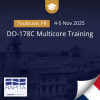 The final blog in our three-part series on recruiting programmers to use Ada features software developer Will Lunniss.
The final blog in our three-part series on recruiting programmers to use Ada features software developer Will Lunniss.
Part 3: Will Lunniss
Will joined Rapita in October 2010 and was the first recruit to combine software development for the company with a four-year EngD in Large-Scale Complex IT Systems through the York-based Large Scale Complex IT Systems Engineering Doctorate Centre. Looking back, Will doesn’t remember Ada cropping up as a major topic when he applied for the EngD. “I had experience of C and Java but had never heard of Ada before I joined Rapita”, says Will. Happily, this lack of experience didn’t hold Will back. “I just picked up a copy of the Ada 95 book and got stuck in”. So it wasn’t long before Will was working on the development of new Rapita tools which have Ada at their core. Nearly three years later and Will has some very positive points to make about Ada. “Unlike some languages, Ada encourages good practice by forcing you think more about algorithms,” says Will. “Strong typing is critical – it promotes data correctness and makes the code very readable. And unlike other languages, such as C++, Ada checks code as you write. This can save a lot of time in the long run.” Good programmers should be able to adapt to Ada without any trouble, says Will.
Conclusions from the three Ada recruits
As with every other programming language, Ada has its pros and cons. Saving time by not writing bug infested code is a major advantage. Any programmer can learn Ada. None of our recruits have been put off by Ada; in fact their experience is largely positive, which suggests the idea that it is difficult to recruit programmers for Ada projects is more myth than reality.

 Hybrid electric pioneers, Ascendance, join Rapita Systems Trailblazer Partnership Program
Hybrid electric pioneers, Ascendance, join Rapita Systems Trailblazer Partnership Program
 Magline joins Rapita Trailblazer Partnership Program to support DO-178 Certification
Magline joins Rapita Trailblazer Partnership Program to support DO-178 Certification
 Eve Air Mobility joins Rapita Systems Trailblazer Partnership Program for eVTOL projects
Eve Air Mobility joins Rapita Systems Trailblazer Partnership Program for eVTOL projects
 How to certify multicore processors - what is everyone asking?
How to certify multicore processors - what is everyone asking?
 Data Coupling Basics in DO-178C
Data Coupling Basics in DO-178C
 Control Coupling Basics in DO-178C
Control Coupling Basics in DO-178C
 Components in Data Coupling and Control Coupling
Components in Data Coupling and Control Coupling
 DO-278A Guidance: Introduction to RTCA DO-278 approval
DO-278A Guidance: Introduction to RTCA DO-278 approval
 ISO 26262
ISO 26262
 Data Coupling & Control Coupling
Data Coupling & Control Coupling
 Verifying additional code for DO-178C
Verifying additional code for DO-178C
 DO-178C Multicore In-person Training (Bristol)
DO-178C Multicore In-person Training (Bristol)
 DO-178C Multicore In-person Training (Fort Worth, TX)
DO-178C Multicore In-person Training (Fort Worth, TX)
 DO-178C Multicore In-person Training (Toulouse)
DO-178C Multicore In-person Training (Toulouse)






















